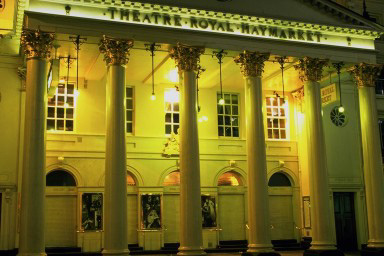-
-
THEATRE ROYAL HAYMARKET: A HISTORY
-

-
| 1720 |
The Little Theatre in the Hay was built by John Potter on the site of the King's Head and the Gun Smith shop. La Fille a la Mode, presented by His Grace the Duke of Montagu, premiered on 29 December. [1] |
| 1729 |
The theatre's first major success, Hurlothrumbo, enjoyed a run of 30 nights. [1] |
| 1737 |
After Henry Fielding leased the theatre to stage a series of anti-Walpole satires, Walpole was sufficiently stung to engineer the passage of the Licensing Act which resulted in the closure of the theatre. The Haymarket was the most prominent of the illegitimate victims of this repressive legislation. [2] |
| 1749 |
The little theatre nearly came to an untimely end through a hoax perpetrated for a wager by the duke of Montagu. One morning the town was thrown into a wonderful state of excitement by the announcement that, on a certain evening, the "Great Bottle Conjurer" would appear at the Haymarket; that, among other extraordinary feats, he would put himself into a quart bottle and sing a song therein; that he would summon up the spirits of dead relations for anyone desirous of seeing them, and enable the living to converse with the dead. On the evening of the alleged appearance, the house was crammed, not with the ignorant and vulgar, but with the fashionable world. After a long delay, during which the dupes grew very impatient, a person came forward and informed the audience that the bottle conjurer was unable to appear that evening, but if they would come again the next, he would undertake to squeeze himself into a pint bottle instead of a quart. The spectators resented the joke; the duke of Cumberland, who was among them, drew his sword, and, leaping upon the stage, called upon everybody to follow him. The people, ripe for mischief, were not slow to accept the prince's invitation. The seats were smashed; the scenery was torn down, and the wreckage carried into the street, where a bonfire was made of it; but for the timely appearance of the authorities the building itself would have been added to the fuel. [3] |
| 1766 |
After ingeniously circumventing the law for several years, Samuel Foote was awarded a limited licence for the Haymarket, probably in compensation for the accident that cost him his leg. By the terms of the license, the Haymarket was permitted to stage legitimate drama during the summer months when the Patent theatres were closed. [2] |
| 1794 |
Twenty people died and many were injured when a vast crowd, anxious to see His Majesty who was attending an evening performance, stampeded the theatre. [1] |
| 1805 |
Hundreds of tailors protested the staging of The Tailors which was seen as an attack on their craft. [4] |
| 1821 |
The Little Theatre in the Hay was abandoned, and a larger theatre was built next door. [5] This new theatre, designed by John Nash, became the Theatre Royal Haymarket. Although the interior has been refashioned many times since, Nash's exterior remains today. [6] |
| 1837 |
The Haymarket became the last theatre in London to use candlelight. Benjamin Webster, the manager at the time, installed gas lighting for the auditorium and stage. [6] |
| 1853 |
John Baldwin Buckstone takes over the management of the theatre. During the course of his career (1853-79), Buckstone oversaw more than 200 successful productions. He is believed by some to be a resident of the theatre to this day, haunting the staff and keeping an eye on his beloved Haymarket. [1] |
| 1862 |
400 performances of Our American Cousin with Edward Southern as Lord Dundreary, adds a new word, "dreary," to the dictionary. John Buckstone clears over 30,000 pounds profit. [1] |
| 1879 |
The auditorium was reconstructed, enclosing the stage in the first complete picture frame proscenium. The pit was also removed and replaced with orchestra stalls, prompting fierce protests from audience members who were used to getting cheap seats near the front. [4] |
| 1893 |
Oscar Wilde premiere's his first comedy, A Woman of No Importance, followed by An Ideal Husband. [1] |
| 1904 |
The theatre was closed for more renovations--this time the house itself, not the stage. The new auditorium was designed by Stanley Peach. [1] |
| 1981 |
Louis I Michaels, Impresario, died. Ownership of the theatre was passed to Louis I Michaels Ltd. [1] |
| 1994 |
1.3 million pounds were spent in a total refurbishment of the house. Twelve hundred layers of twenty four carat English gold leaf were installed, the stage roof and trusses were reinforced, the roof was restored, and 2000 lead crystals from the central chandelier were cleaned. [1] |
Purchase Books on the Haymarket Theatre
Search eBay! for Haymarket Theatre collectibles
-
1 "TRH - History." http://www.trh.co.uk/trh/
2 "Haymarket, Theatre Royal." The Cambridge Guide to Theatre. Cambridge: Cambridge University Press, 1995. p. 477-78.
3 The Drama: Its History, Literature and Influence on Civilization, vol. 15. ed. Alfred Bates. London: Historical Publishing Company, 1906. pp. 96-97.
4 "Haymarket Theatre Royal." http://www.theatreticket.com/haymarket.html
5 The Development of the Playhouse: A Survey of Theatre Architecture from the Renaissance to the Present. Mullin, Donald C. Los Angeles: University of California Press, 1970.
6 "Haymarket Theatre, London." The Oxford Companion to the Theatre. 4th ed. Oxford: Oxford University Press, 1983.
|
|
|
|
|